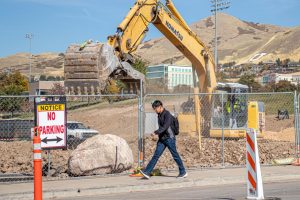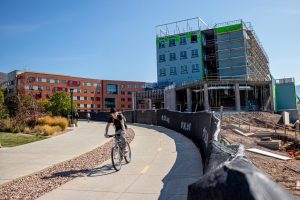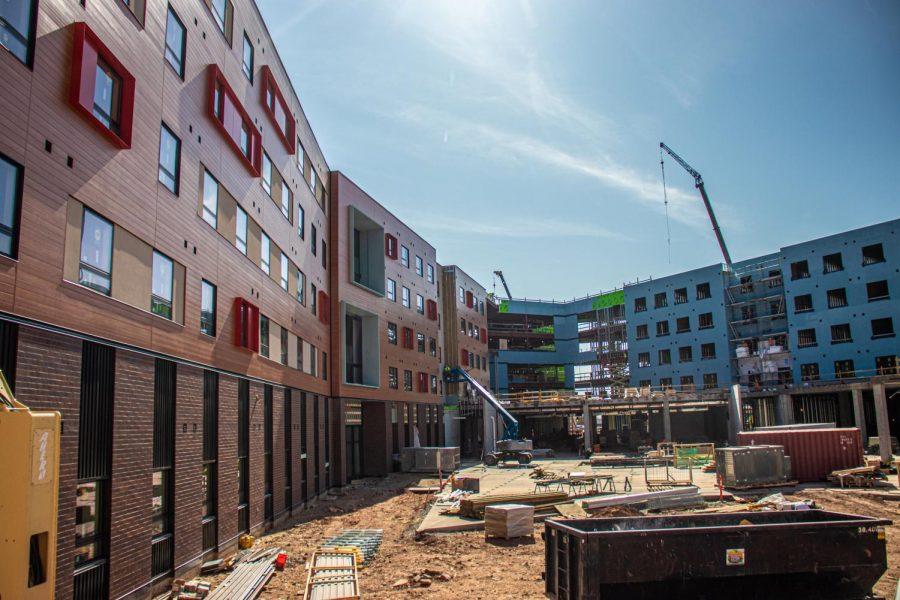Are We a College Town or a Commuter Campus?
The in-construction Kahert Village Residence Dorms, University of Utah Campus, Salt Lake City, UT on Monday, October 14th, 2019. (Photo by Mark Draper | The Daily Utah Chronicle)
October 22, 2019
Housing on campus is growing with the construction of Kahlert Village underway. The Kahlert Village will soon become one of the University of Utah’s newest housing options starting Fall 2020, according to Assistant Director for Communications and Assessment Lexie Maschoff.
Currently, the U holds 10 residence halls, 10 Officers Circle homes and nine apartment buildings, all of which are located in the Heritage Commons area. Lower-campus housing includes the Marriott Honors Community and Lassonde Studios. There are also several off-campus housing options that the U supports.
Housing and Residential Education houses about 3,700 students, but as Kahlert Village finishes construction alongside a few other occupancy adjustments, it’s estimated that HRE will then house approximately 4,300.
Machoff also said Kahlert Village will welcome 992 first-year students. The building will include not only first-year honor housing, but also a full-service dining hall, classrooms, study spaces and other student resources.
While the building will be home to the Kahlert Initiative for Technology — a new initiative on campus designed to support digital literacy across all majors — it will also highlight the following living-learning/themed communities: Heather Kahlert STEM Tower, Patricia W. Child Health & Wellness Tower and the Gail Miller Community Engagement Tower.

Even with the increase in housing options, some students voiced concerns with Commuter Services that arose because of the constructions on campus.
“Parking has never been an easy thing at the U as a student or alumni. I would donate to the U as an alumnus if it weren’t for commuter services. There’s never parking available for students, for employees or for visitors. Even when I’ve purchased an overpriced parking permit, I still couldn’t find any open spots,” Danielle Dreis, U alumna and employee, said.
According to the director of Commuter Services, Alma Allred, there are 6,102 current student parking spaces, but still U students seem frustrated due to the limited options near central campus. An online petition that trended on Facebook was created to “storm” Commuter Services, with the hope that with signing a petition, changes would be made to increase parking.
“It’s frustrating that they are taking away parking that already isn’t enough just to create more housing — housing that’s primarily targeted towards new students. We pay $260 for a parking pass and then have the university take away major lots. Not only do they oversell permits, they also contribute to us being late to our classes. We’re literally circling lots for an hour trying to find a spot just to end up having to park so far away,” said Aubrey Olsen, a senior strategic communications major.
Allred also said there is actually more parking on campus than in all previous years. In 2015, there were 5,860 student parking spaces. In 2016, there were 5,782, which grew to 5,661 in 2017, 5,458 in 2018 and today in 2019, 6,102.

“The thing is that a lot of students don’t like the fact that they have to walk,” Allred said. With construction taking place on top of previous lots, close parking seems rather difficult to find. “People want plentiful, cheap and convenient parking. They want to park right next to where they are going and not have to worry about walking very far,” he added.
It costs a lot of money to create more parking on central campus, and that money doesn’t come from the university. It actually comes out of the pockets of Commuter Services. Surprisingly, according to Allred, student tuition doesn’t pay for parking development — it is entirely paid through permit purchases and paid citations.
“The reality is, it costs about $7,500 to build a surface parking space, which will only last five to seven years since asphalt is a temporary thing. And with that lot, [as a student] you’re going to then have to get $937 per year to pay for that. … The cost of a permit doesn’t quite cover the expense of building it,” Allred said.
Despite central parking being limited, Commuter Services, in association with UTA, supplies transit service for those attending and working at the U, paid through student fees. The agreement provides students, faculty and staff access to TRAX, UTA buses and Frontrunner trains with valid university ID. For those who are struggling with parking, consider simply going green and taking up this public transit opportunity that students are already paying for.
In response to the changes occurring at the university, Zachary Adams, a junior majoring in chemistry, said, “I think it’s a good thing that the U is becoming less of a commuter school. Driving is bad. I know it’s inconvenient for a lot of people right now, but overall, this will be something good for our environment and our student body.”











